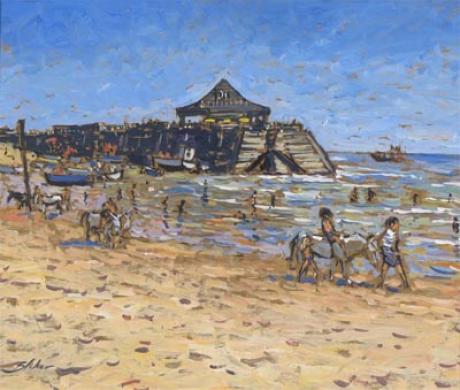signed
Broadstairs is a coastal town on the Isle of Thanet in the Thanet district of east Kent, England, about 80 miles (130 km) south-east of London. It is part of the civil parish of Broadstairs and St Peter's, which includes St. Peter's and had a population in 2001 of about 24,000. Situated between Margate and Ramsgate, Broadstairs is one of Thanet's seaside resorts, known as the "Jewel in Thanet's crown". The town's crest motto is Stella Maris ("Star of the Sea"). The name derives from a former flight of steps in the chalk cliff, which led from the sands up to the 11th-century shrine of St Mary on the cliff's summit. The town spreads from Haine Road[citation needed]in the west to Kingsgate in the north (named after the landing of King Charles II in 1683) and to Dumpton in the south (named after the yeoman Dudeman who farmed there in the 13th century). The hamlet of Reading (formerly Reden or Redyng) Street was established by Flemish refugees in the 17th century. The inland village of St Peters was established after the building of a parish church in about 1080. On the nearby coast was a cliff-top shrine, the Shrine of Our Lady, at what was then called Bradstow(e), meaning "broad place" (perhaps referring to the wide bay). A fishing settlement developed in the vicinity of the shrine in the 14th century. This came to be called "Broadstairs", after a flight of steps which was made in the cliff to give access to the shrine from the bay. Older forms of the name include Brodsteyr Lynch (1434), Brodestyr (1479), Broadstayer (1565) and Brod stayrs (1610). Charles Culmer, son of Waldemar, is supposed to have reconstructed the stairs in 1350. In 1440, an archway was built by George Culmer across a track leading down to the sea, where the first wooden pier or jetty was built in 1460. A more enduring structure was to replace this in 1538, when the road leading to the seafront, known as Harbour Street, was cut into the rough chalk ground on which Broadstairs is built, by another George Culmer. Going further in defence of the town, he built the York Gate in 1540, a portal that still spans Harbour Street and which then held two heavy wooden doors that could be closed in times of threat from the sea. Richard Culmer was the son of Sir Richard Culmer by his first wife and was born in 1640/41. Richard was buried in the parish church of Monkton, on the Isle of Thanet. Of his legacies was the endowment on Broadstairs of an area of six acres (24,000 m²) of ground for the poor of the parish. The name survives to this day as "Culmer's Allotment" as does the allotment. In 1723, Broadstairs had a population of about 300. A brief outline of the history of Broadstairs Pier is given in Broadstairs, past and present, which mentions a storm in 1767, during which Culmer's work was all but destroyed. At this time, it was of considerable importance to the fishing trade with catches as far afield as Great Yarmouth, Hastings, Folkestone, Dover and Torbay and elsewhere being landed. It had become so indispensable that the corporations of Yarmouth, Dover, Hythe and Canterbury with assistance from the East India Company and Trinity House subscribed to its restoration with a payment of £2,000 in 1774. By 1795, York Gate needed repair to repel any threat from the French Revolutionary Wars. The subsequent renovation was undertaken by Lord Hanniker in the same year as the first lightvessel was placed on the Goodwin Sands. On the occasion of the landing at Thanet of Major Henry Percy of the 14th Dragoon Guards, on 21 June 1815 with the captured French eagle standard taken at Waterloo, a tunnel stairway from the beach to the fields on the clifftops above was excavated, and christened "Waterloo Stairs" to commemorate the event. Broadstairs was supposedly the first town in England to learn of this historic victory, although there is no written evidence of this. Smuggling was an important industry in the area, and the men of Broadstairs and St Peters became very good at outwitting customs agents. This was very profitable because of the very high duty payable on tea, spirits and tobacco. There is a network of tunnels and caves strewn in the chalk strata which were used by smugglers to hide their contraband. By 1824 steamboats were becoming more common, having begun to take over from the hoys and sailing packets about 1814. These made trade with London much faster. The familiar sailing hoys took anything up to 72 hours to reach Margate from London, whereas the new steamships were capable of making at least nine voyages in this time. Mixed feelings must have been strongly expressed by the Thanet boatmen in general, as the unrivalled speed of the steam packet was outmanoeuvering all other classes of vessel, but it brought a new prosperity to Thanet. In the middle of the 19th century, the professional classes began to move in. By 1850, the population had reached about 3,000, doubling over the previous 50 years. Due to the fresh sea air, many convalescent homes for children opened towards the end of the 19th century.

